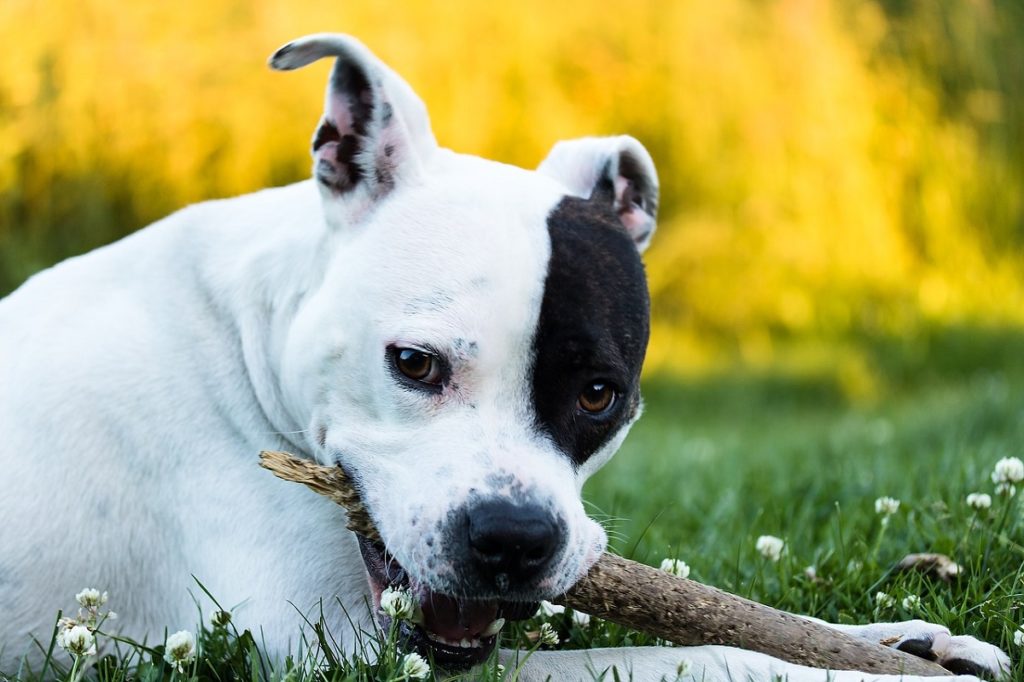Every dog is sure to get stung by a bee now and then. Dogs are extremely curious little creatures, they love to explore and investigate, and if something is flying around outside, they are almost duty-bound to chase it. They might even try to bite it or eat it. Sometimes a dog is stung by a bee from stepping on a nest or a lone bee by accident. This means that the probability of them getting stung by wasps, hornets, and bees at some point in their lifetime is quite high, never mind the chances of getting bitten by other critters like mosquitoes, horseflies, ants, and spiders!
In most cases, even though it can definitely be painful, a bee sting is relatively harmless unless your dog happens to have a severe allergy to the bee venom. However, if your dog gets stung multiple times in a short period of time (for instance, if they stumble onto a beehive and get attacked by several bees at once), then that can be dangerous for a dog. That’s like bee venom overload and it can quickly become a very serious situation if your dog is at all sensitive or allergic to bee venom.
If you already know your dog is allergic, you should take steps to slow down the progression of symptoms by giving your dog Benadryl and get your canine to the vet immediately. If you don’t know whether or not your dog is allergic, it can’t hurt to give them a dose of Benadryl anyway just to be safe and monitor him closely. If you notice any swelling or drooling or difficulty breathing in your dog, seek medical care right away.
How Do You Know Your Dog Was Stung by a Bee?
Though there are some cases where you might not realize your dog has been stung by a bee because they show no signs or symptoms, in most cases, when a dog gets stung, you will usually know it. Bee stings are quite painful, and most dogs will react to the sting with some kind of yelp or bark to alert you something has happened. Not only that, because many dogs (much like many people) are highly sensitive to bee venom, they could suffer a canine allergic reaction that may or may not need the attention of a veterinarian, so it’s important to watch him closely… his bodily response can alert you that he’s been stung.
Regardless of whether or not he is allergic, if your dog has been running around the yard, shoving his sniffer into beds of flowers, and chasing everything that moves, you can probably reasonably deduce he’s been bitten or stung by something when he cries out in pain. A dog is most vulnerable in tender areas like their nose and mouth. Since that’s what they use to investigate with the most, it stands to reason they may accidentally stick their snout somewhere they probably shouldn’t and end up with a boo boo. Ouch!
Vulnerabilities aren’t limited to their nose and mouth though. Dogs can also get stung by a bee on their paws, too, usually because they’ve stepped on one of the little buzzers and it still had the stinger attached. Once a dog has been stung by a bee, the stinger may be left behind in their skin and continue to release venom into the dog’s body until it is removed, which isn’t quite as easy as it sounds.
Unfortunately, bees have small, barbed little stingers that are designed to attach and stay put, kind of like a little fish hook. Once a stinger has been detached from the bee, the bee dies, but sadly, the effects of the stinger itself do not. The stinger has to be removed, and it has to be done carefully, without using your fingers or tweezers.
 This is largely because fingers or tweezers can accidentally squeeze more bee venom into your dog’s body, which is counterintuitive. The additional venom can create more havoc than you bargained for, especially if your dog is already highly allergic. The safest way to remove a bee stinger from a dog is to brush at it gently with the edge of a credit card or something similar, until the barb loosens, and the stinger falls out on its own.
This is largely because fingers or tweezers can accidentally squeeze more bee venom into your dog’s body, which is counterintuitive. The additional venom can create more havoc than you bargained for, especially if your dog is already highly allergic. The safest way to remove a bee stinger from a dog is to brush at it gently with the edge of a credit card or something similar, until the barb loosens, and the stinger falls out on its own.
You definitely don’t want to just leave it there, because the venom from a bee’s stinger can continue to be pumped into the dog’s system for up to three minutes if it’s not removed right away. That’s why it’s so important to locate the bee sting site and make sure the stinger hasn’t been left behind, if you suspect a bee is the source of your dog’s pain.
Symptoms of a Bee Sting in Dogs
Reactions to a bee sting can be highly variable, even reactions in the same dog. He might not react the first time he is stung, your pup can break out in hives the next time they are stung, and experience full on anaphylactic shock with the next bee sting. That makes predicting what will happen when your dog is stung by a bee extremely difficult.
This means you always need to be prepared for the worst-case scenario if your dog is stung. And it’s really not even a case of “if” but of “when.” All dogs run across insects in their lifetime and at some point, your dog will too, including getting stung by a bee. Being prepared ahead of time for how you will respond can save you a lot of stress in the moment.
To determine for certain whether or not your dog has been stung, you should first inspect their body thoroughly, paying special attention to areas like their nose, their mouth, their lips and paws, and especially the tender skin between their toes. Look for the site of the sting, so you can clean and treat the wound and remove the stinger if it’s still there.
Then, monitor your dog carefully for symptoms. Some dogs will just experience a raised, red welt at the site of the sting. Other dogs may lick, bite, or chew the area they have been stung in. You may notice swelling of the area, and in more severe cases, dogs can develop hives that will arise all over their body.
Dogs can also suffer from diarrhea, vomiting, anxiety and restlessness, drooling, weakness, disorientation and dizziness, and a lack of coordination. In very severe cases, major swelling can occur in your dog’s face, neck, and throat. This swelling can occlude your dog’s airways and restrict their ability to breathe. When your dog is having breathing difficulties, you may notice they wheeze, pant, and possibly develop a blue tint to their gums and mucous membranes which is indicative of a lack of oxygen to their body.
Dogs can also collapse, have canine seizures, go into shock, and even die from very severe reactions, so it’s important to see your vet right away if you suspect your dog has been stung and may be suffering from anaphylactic shock. Symptoms can progress quickly, so time is of the essence.
Home Treatments for Bee Stings in Dogs
You should take your dog to the vet as soon as possible if it appears as though they are suffering from an allergic reaction to the bee sting. However, in the event that you can’t make it there fast enough, or if you choose to treat your dog’s bee sting at home, you can administer Benadryl for dogs as a way to counteract their symptoms.
It’s highly recommended to call your vet or a pharmacist before giving a dog any kind of drug, so that you can determine the best dosage for your dog and their size. You don’t want to accidentally overdose them in the heat of the moment. Benadryl is generally safe to give to a dog in the proper dosage and can help slow down the symptoms of an allergic reaction and give you time to seek medical help if necessary.
If your dog has been stung yet doesn’t seem to be having an allergic reaction, you can probably safely treat the bee sting at home and skip the vet. Try applying ice or a cold compress to the site to reduce any swelling and use a paste of water and baking soda to help reduce the stinging sensation and pain.
Apple side vinegar is sometimes used with success to help neutralize bee sting venom as well. Just apply the cider vinegar to the wound using a cotton ball and repeat as needed. Another remedy often used for bee stings is aloe vera gel applied to the wound. You can also try a soothing oatmeal bath to relieve itching.
Vet Care for Bee Stings
 If you find your dog’s reaction to be severe, you should seek medical treatment as soon as possible and don’t wait. They will most likely give your dog Benadryl themselves if you haven’t already, as well as administer steroid drugs and/or epinephrine.
If you find your dog’s reaction to be severe, you should seek medical treatment as soon as possible and don’t wait. They will most likely give your dog Benadryl themselves if you haven’t already, as well as administer steroid drugs and/or epinephrine.
If your dog is having difficulty breathing, they may administer oxygen as well as IV fluids, especially if your dog has been vomiting, experiencing excessive urination, spontaneous defecation, and/or diarrhea. If your dog’s airways are swollen shut, an emergency tracheotomy is sometimes necessary so that your dog can breathe until the swelling goes down. You can expect your dog to stay overnight in very severe cases, and maybe even stay a few days in order to recovery fully and be well enough to go home.
Bee Sting Prevention for Dogs
While it’s impossible to fully prevent the possibility of a dog being stung by a bee, you can take steps to make sure your yard is bee free with the help of an exterminator. You can also monitor your dog closely when he is outdoors and keep him out of flower beds and places bees like to congregate, including areas where there is fruit on the ground (bees like fruit), and areas where the grass is tall. Keep your lawn mowed short and limit the amount of time your dog spends outside, especially during seasons you know bees are prevalent.
You should also make sure that if your dog is stung by a bee in your yard somewhere, you remove the threat right away, so they don’t get stung again. Make sure there is no hive or nest on the ground or in a tree. Unfortunately, dogs that are stung more than once, especially in a short period of time, are more prone to an allergic reaction than a dog that’s only stung once.
If your dog has a known allergy to bee stings, you can also be proactive by giving your dog a series of shots designed specifically to desensitize them to bee stings and their venom. Basically, you are giving your dog small, controlled doses of bee venom so that their body gets used to the effects and as a result, the dangers of a severe reaction are significantly reduced.
You can also give your dog Benadryl as a daily preventative measure, especially if you have certain times of year where bee stings are more prone to happen. While this doesn’t always work, it can help potentially reduce the severity of a reaction, provided your dog is stung during a time when the medication is still in their system. Note that Benadryl can cause drowsiness, so if you notice your dog is sleeping too much, you may want to skip this preventative measure.
Another thing you can do is to speak to your vet about prescribing your dog an epinephrine pen that you can carry with you when you’re out and about. You can use an epinephrine pen with a dog the same way you would with a person, and it can be a literal lifesaver for dogs with known and severe reactions.
A quick response is vital in alleviating the symptoms of anaphylactic shock. Using a pen to deliver a quick shot of epinephrine may just be what is needed to save your dog’s life in an emergency situation. Though bee stings can seem innocent enough, it’s always better to be safe than sorry.
Sources:
- Lefler, Leah. “Bee Sting Reactions and Treatment for Dogs.” PetHelpful, 28 July 2017, Accessed 6 Nov. 2018. www.pethelpful.com/dogs/Dog-Allergies-Bee-Sting-Reactions-and-Treatment.
- Moore, Arden. “What to Do When Your Kitty or Puppy Gets a Bee Sting.” Vetstreet, Accessed 6 Nov. 2018. www.vetstreet.com/our-pet-experts/bee-stings-101-how-to-help-your-pet.
- “Bee Sting Allergies in Dogs – Symptoms, Causes, Diagnosis, Treatment, Recovery, Management, Cost.” WagWalking, 17 Aug. 2016, Accessed 6 Nov. 2018. www.wagwalking.com/condition/bee-sting-allergies.




